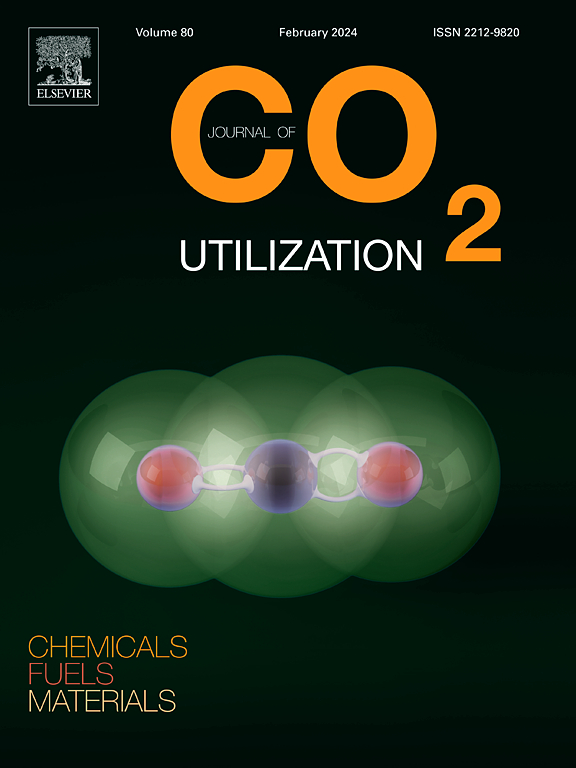A pathway to cyclic carbonates: Cycloaddition of carbon dioxide to epoxidized methyl oleate on grafted heterogeneous catalysts
IF 7.2
2区 工程技术
Q1 CHEMISTRY, MULTIDISCIPLINARY
引用次数: 0
Abstract
The conversion of CO2 into value-added cyclic carbonates via cycloaddition to bio-derived epoxides presents a sustainable approach for CO2 utilization. However, the production of cyclic carbonates from bio-sources such as epoxidized vegetable oils (EVOs) have significant challenges due to the low reactivity of CO2 and the steric hindrance of internal epoxides in these bulky substrates. Consequently, the majority of systems for CO2 fixation to bio-based epoxides rely on homogeneous catalysis. This study investigated the conversion of epoxidized methyl oleate, a model compound for EVOs, into its corresponding cyclic carbonate using heterogeneous 4-pyrrolidinopyridine-based catalysts. The influence of various catalytic parameters, such as the halide counter anions (Cl, Br, I) and incorporated metal Lewis acid centra, was explored within the catalyst. Among the halide counter anions, bromide exhibited a superior performance, achieving 65 % conversion and 59 % cyclic carbonate yield by the end of the experiment, while the effect of various metal centra was less pronounced, with an overall improvement in the cyclic carbonate yield of less than 10 % compared to the metal-free catalyst. A comprehensive study of reaction parameters, including the temperature (100–170°C), the CO2 pressure (20–40 bar), and the catalyst loading (2.9–10.7 wt%), was conducted in a laboratory-scale autoclave reactor to elucidate the behavior of the reaction system.
合成环状碳酸盐的途径:二氧化碳在接枝非均相催化剂上环加成环氧化油酸甲酯
通过生物衍生环氧化物的环加成将二氧化碳转化为增值的环状碳酸盐是一种可持续利用二氧化碳的方法。然而,从生物源如环氧化植物油(evo)中生产环状碳酸盐面临着巨大的挑战,因为这些笨重的底物中二氧化碳的低反应性和内部环氧化物的空间位阻。因此,大多数将二氧化碳固定到生物基环氧化物的系统依赖于均相催化。本研究采用非均相4-吡咯烷二吡啶为催化剂,研究了环氧化油酸甲酯(evo的模型化合物)转化为相应的环碳酸盐。考察了催化剂中卤化物反阴离子(Cl、Br、I)和掺入金属路易斯酸中心等不同催化参数对反应的影响。在卤化物反阴离子中,溴化物表现出优异的性能,在实验结束时达到65 %的转化率和59 %的环碳酸盐收率,而各种金属中心的影响不太明显,与无金属催化剂相比,环碳酸盐收率总体提高不到10 %。在实验室规模的高压釜反应器中进行了反应参数的综合研究,包括温度(100-170°C), CO2压力(20-40 bar)和催化剂负载(2.9-10.7 wt%),以阐明反应体系的行为。
本文章由计算机程序翻译,如有差异,请以英文原文为准。
求助全文
约1分钟内获得全文
求助全文
来源期刊

Journal of CO2 Utilization
CHEMISTRY, MULTIDISCIPLINARY-ENGINEERING, CHEMICAL
CiteScore
13.90
自引率
10.40%
发文量
406
审稿时长
2.8 months
期刊介绍:
The Journal of CO2 Utilization offers a single, multi-disciplinary, scholarly platform for the exchange of novel research in the field of CO2 re-use for scientists and engineers in chemicals, fuels and materials.
The emphasis is on the dissemination of leading-edge research from basic science to the development of new processes, technologies and applications.
The Journal of CO2 Utilization publishes original peer-reviewed research papers, reviews, and short communications, including experimental and theoretical work, and analytical models and simulations.
 求助内容:
求助内容: 应助结果提醒方式:
应助结果提醒方式:


